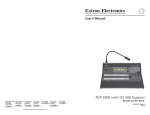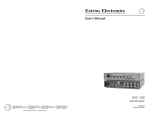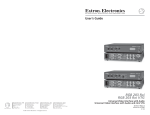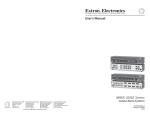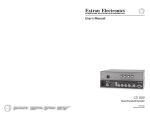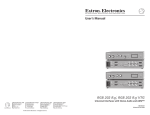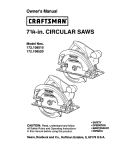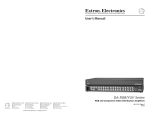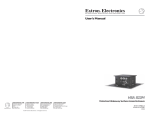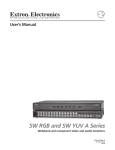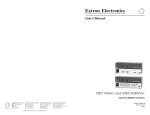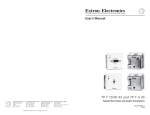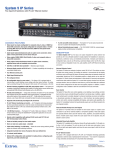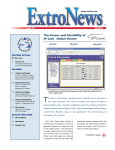Download Extron electronic Extron Electronics Switch RCP 2000 User's Manual
Transcript
User’s Manual RCP 2000 Remote Control Panel www.extron.com Extron Electronics, USA Extron Electronics, Europe Extron Electronics, Asia Extron Electronics, Japan 1230 South Lewis Street Anaheim, CA 92805 USA 714.491.1500 Fax 714.491.1517 Beeldschermweg 6C 3821 AH Amersfoort The Netherlands +31.33.453.4040 Fax +31.33.453.4050 135 Joo Seng Road, #04-01 PM Industrial Building Singapore 368363 +65.6383.4400 Fax +65.6383.4664 Kyodo Building 16 Ichibancho Chiyoda-ku, Tokyo 102-0082 Japan +81.3.3511.7655 Fax +81.3.3511.7656 © 2005 Extron Electronics. All rights reserved. 68-792-01 Rev. C 03 05 FCC Class A Notice Precautions Safety Instructions • English This symbol is intended to alert the user of important operating and maintenance (servicing) instructions in the literature provided with the equipment. This symbol is intended to alert the user of the presence of uninsulated dangerous voltage within the product's enclosure that may present a risk of electric shock. Caution Read Instructions • Read and understand all safety and operating instructions before using the equipment. Retain Instructions • The safety instructions should be kept for future reference. Follow Warnings • Follow all warnings and instructions marked on the equipment or in the user information. Avoid Attachments • Do not use tools or attachments that are not recommended by the equipment manufacturer because they may be hazardous. Consignes de Sécurité • Français Ce symbole sert à avertir l’utilisateur que la documentation fournie avec le matériel contient des instructions importantes concernant l’exploitation et la maintenance (réparation). Ce symbole sert à avertir l’utilisateur de la présence dans le boîtier de l’appareil de tensions dangereuses non isolées posant des risques d’électrocution. Attention Lire les instructions• Prendre connaissance de toutes les consignes de sécurité et d’exploitation avant d’utiliser le matériel. Conserver les instructions• Ranger les consignes de sécurité afin de pouvoir les consulter à l’avenir. Respecter les avertissements • Observer tous les avertissements et consignes marqués sur le matériel ou présentés dans la documentation utilisateur. Eviter les pièces de fixation • Ne pas utiliser de pièces de fixation ni d’outils non recommandés par le fabricant du matériel car cela risquerait de poser certains dangers. Sicherheitsanleitungen • Deutsch Dieses Symbol soll dem Benutzer in der im Lieferumfang enthaltenen Dokumentation besonders wichtige Hinweise zur Bedienung und Wartung (Instandhaltung) geben. Dieses Symbol soll den Benutzer darauf aufmerksam machen, daß im Inneren des Gehäuses dieses Produktes gefährliche Spannungen, die nicht isoliert sind und die einen elektrischen Schock verursachen können, herrschen. Achtung Lesen der Anleitungen • Bevor Sie das Gerät zum ersten Mal verwenden, sollten Sie alle Sicherheits-und Bedienungsanleitungen genau durchlesen und verstehen. Aufbewahren der Anleitungen • Die Hinweise zur elektrischen Sicherheit des Produktes sollten Sie aufbewahren, damit Sie im Bedarfsfall darauf zurückgreifen können. Befolgen der Warnhinweise • Befolgen Sie alle Warnhinweise und Anleitungen auf dem Gerät oder in der Benutzerdokumentation. Keine Zusatzgeräte • Verwenden Sie keine Werkzeuge oder Zusatzgeräte, die nicht ausdrücklich vom Hersteller empfohlen wurden, da diese eine Gefahrenquelle darstellen können. Instrucciones de seguridad • Español Este símbolo se utiliza para advertir al usuario sobre instrucciones importantes de operación y mantenimiento (o cambio de partes) que se desean destacar en el contenido de la documentación suministrada con los equipos. Este símbolo se utiliza para advertir al usuario sobre la presencia de elementos con voltaje peligroso sin protección aislante, que puedan encontrarse dentro de la caja o alojamiento del producto, y que puedan representar riesgo de electrocución. Precaucion Leer las instrucciones • Leer y analizar todas las instrucciones de operación y seguridad, antes de usar el equipo. Conservar las instrucciones • Conservar las instrucciones de seguridad para futura consulta. Obedecer las advertencias • Todas las advertencias e instrucciones marcadas en el equipo o en la documentación del usuario, deben ser obedecidas. Evitar el uso de accesorios • No usar herramientas o accesorios que no sean especificamente recomendados por el fabricante, ya que podrian implicar riesgos. Warning Power sources • This equipment should be operated only from the power source indicated on the product. This equipment is intended to be used with a main power system with a grounded (neutral) conductor. The third (grounding) pin is a safety feature, do not attempt to bypass or disable it. Power disconnection • To remove power from the equipment safely, remove all power cords from the rear of the equipment, or the desktop power module (if detachable), or from the power source receptacle (wall plug). Power cord protection • Power cords should be routed so that they are not likely to be stepped on or pinched by items placed upon or against them. Servicing • Refer all servicing to qualified service personnel. There are no userserviceable parts inside. To prevent the risk of shock, do not attempt to service this equipment yourself because opening or removing covers may expose you to dangerous voltage or other hazards. Slots and openings • If the equipment has slots or holes in the enclosure, these are provided to prevent overheating of sensitive components inside. These openings must never be blocked by other objects. Lithium battery • There is a danger of explosion if battery is incorrectly replaced. Replace it only with the same or equivalent type recommended by the manufacturer. Dispose of used batteries according to the manufacturer's instructions. Avertissement Alimentations• Ne faire fonctionner ce matériel qu’avec la source d’alimentation indiquée sur l’appareil. Ce matériel doit être utilisé avec une alimentation principale comportant un fil de terre (neutre). Le troisième contact (de mise à la terre) constitue un dispositif de sécurité : n’essayez pas de la contourner ni de la désactiver. Déconnexion de l’alimentation• Pour mettre le matériel hors tension sans danger, déconnectez tous les cordons d’alimentation de l’arrière de l’appareil ou du module d’alimentation de bureau (s’il est amovible) ou encore de la prise secteur. Protection du cordon d’alimentation • Acheminer les cordons d’alimentation de manière à ce que personne ne risque de marcher dessus et à ce qu’ils ne soient pas écrasés ou pincés par des objets. Réparation-maintenance • Faire exécuter toutes les interventions de réparationmaintenance par un technicien qualifié. Aucun des éléments internes ne peut être réparé par l’utilisateur. Afin d’éviter tout danger d’électrocution, l’utilisateur ne doit pas essayer de procéder lui-même à ces opérations car l’ouverture ou le retrait des couvercles risquent de l’exposer à de hautes tensions et autres dangers. Fentes et orifices • Si le boîtier de l’appareil comporte des fentes ou des orifices, ceux-ci servent à empêcher les composants internes sensibles de surchauffer. Ces ouvertures ne doivent jamais être bloquées par des objets. Lithium Batterie • Il a danger d'explosion s'll y a remplacment incorrect de la batterie. Remplacer uniquement avec une batterie du meme type ou d'un ype equivalent recommande par le constructeur. Mettre au reut les batteries usagees conformement aux instructions du fabricant. Vorsicht Stromquellen • Dieses Gerät sollte nur über die auf dem Produkt angegebene Stromquelle betrieben werden. Dieses Gerät wurde für eine Verwendung mit einer Hauptstromleitung mit einem geerdeten (neutralen) Leiter konzipiert. Der dritte Kontakt ist für einen Erdanschluß, und stellt eine Sicherheitsfunktion dar. Diese sollte nicht umgangen oder außer Betrieb gesetzt werden. Stromunterbrechung • Um das Gerät auf sichere Weise vom Netz zu trennen, sollten Sie alle Netzkabel aus der Rückseite des Gerätes, aus der externen Stomversorgung (falls dies möglich ist) oder aus der Wandsteckdose ziehen. Schutz des Netzkabels • Netzkabel sollten stets so verlegt werden, daß sie nicht im Weg liegen und niemand darauf treten kann oder Objekte darauf- oder unmittelbar dagegengestellt werden können. Wartung • Alle Wartungsmaßnahmen sollten nur von qualifiziertem Servicepersonal durchgeführt werden. Die internen Komponenten des Gerätes sind wartungsfrei. Zur Vermeidung eines elektrischen Schocks versuchen Sie in keinem Fall, dieses Gerät selbst öffnen, da beim Entfernen der Abdeckungen die Gefahr eines elektrischen Schlags und/oder andere Gefahren bestehen. Schlitze und Öffnungen • Wenn das Gerät Schlitze oder Löcher im Gehäuse aufweist, dienen diese zur Vermeidung einer Überhitzung der empfindlichen Teile im Inneren. Diese Öffnungen dürfen niemals von anderen Objekten blockiert werden. Litium-Batterie • Explosionsgefahr, falls die Batterie nicht richtig ersetzt wird. Ersetzen Sie verbrauchte Batterien nur durch den gleichen oder einen vergleichbaren Batterietyp, der auch vom Hersteller empfohlen wird. Entsorgen Sie verbrauchte Batterien bitte gemäß den Herstelleranweisungen. Advertencia Alimentación eléctrica • Este equipo debe conectarse únicamente a la fuente/tipo de alimentación eléctrica indicada en el mismo. La alimentación eléctrica de este equipo debe provenir de un sistema de distribución general con conductor neutro a tierra. La tercera pata (puesta a tierra) es una medida de seguridad, no puentearia ni eliminaria. Desconexión de alimentación eléctrica • Para desconectar con seguridad la acometida de alimentación eléctrica al equipo, desenchufar todos los cables de alimentación en el panel trasero del equipo, o desenchufar el módulo de alimentación (si fuera independiente), o desenchufar el cable del receptáculo de la pared. Protección del cables de alimentación • Los cables de alimentación eléctrica se deben instalar en lugares donde no sean pisados ni apretados por objetos que se puedan apoyar sobre ellos. Reparaciones/mantenimiento • Solicitar siempre los servicios técnicos de personal calificado. En el interior no hay partes a las que el usuario deba acceder. Para evitar riesgo de electrocución, no intentar personalmente la reparación/ mantenimiento de este equipo, ya que al abrir o extraer las tapas puede quedar expuesto a voltajes peligrosos u otros riesgos. Ranuras y aberturas • Si el equipo posee ranuras o orificios en su caja/alojamiento, es para evitar el sobrecalientamiento de componentes internos sensibles. Estas aberturas nunca se deben obstruir con otros objetos. Batería de litio • Existe riesgo de explosión si esta batería se coloca en la posición incorrecta. Cambiar esta batería únicamente con el mismo tipo (o su equivalente) recomendado por el fabricante. Desachar las baterías usadas siguiendo las instrucciones del fabricante. Note: This equipment has been tested and found to comply with the limits for a Class A digital device, pursuant to part 15 of the FCC Rules. These limits are designed to provide reasonable protection against harmful interference when the equipment is operated in a commercial environment. This equipment generates, uses and can radiate radio frequency energy and, if not installed and used in accordance with the instruction manual, may cause harmful interference to radio communications. Operation of this equipment in a residential area is likely to cause harmful interference, in which case the user will be required to correct the interference at his own expense. Note: This unit was tested with shielded cables on the peripheral devices. Shielded cables must be used with the unit to ensure compliance. Extron’s Warranty Extron Electronics warrants this product against defects in materials and workmanship for a period of three years from the date of purchase. In the event of malfunction during the warranty period attributable directly to faulty workmanship and/or materials, Extron Electronics will, at its option, repair or replace said products or components, to whatever extent it shall deem necessary to restore said product to proper operating condition, provided that it is returned within the warranty period, with proof of purchase and description of malfunction to: USA, Canada, South America, and Central America: Europe, Africa, and the Middle East: Extron Electronics 1001 East Ball Road Anaheim, CA 92805, USA Extron Electronics, Europe Beeldschermweg 6C 3821 AH Amersfoort The Netherlands Asia: Japan: Extron Electronics, Asia 135 Joo Seng Road, #04-01 PM Industrial Bldg. Singapore 368363 Extron Electronics, Japan Kyodo Building 16 Ichibancho Chiyoda-ku, Tokyo 102-0082 Japan This Limited Warranty does not apply if the fault has been caused by misuse, improper handling care, electrical or mechanical abuse, abnormal operating conditions or non-Extron authorized modification to the product. If it has been determined that the product is defective, please call Extron and ask for an Applications Engineer at (714) 491-1500 (USA), 31.33.453.4040 (Europe), 65.6383.4400 (Asia), or 81.3.3511.7655 (Japan) to receive an RA# (Return Authorization number). This will begin the repair process as quickly as possible. Units must be returned insured, with shipping charges prepaid. If not insured, you assume the risk of loss or damage during shipment. Returned units must include the serial number and a description of the problem, as well as the name of the person to contact in case there are any questions. Extron Electronics makes no further warranties either expressed or implied with respect to the product and its quality, performance, merchantability, or fitness for any particular use. In no event will Extron Electronics be liable for direct, indirect, or consequential damages resulting from any defect in this product even if Extron Electronics has been advised of such damage. Please note that laws vary from state to state and country to country, and that some provisions of this warranty may not apply to you. Quick Start Guide — RCP 2000 Step 1 Turn the equipment off and disconnect it from the power source. Make sure that the ISS 108/408 or SGS 408 and all attached devices are turned off and, if applicable, disconnected from the power source. Step 2 Set the RCP 2000 on a table or other flat surface. Step 3 SGS Switcher: Attach one of the RS-232 cables provided with the RCP 2000 between the RS-232 Remote port on the rear panel of the SGS and the To Switcher port on the rear panel of the RCP 2000. ISS Switcher: Attach one of the RS-232 cables provided with the RCP 2000 between the RS-232 port on the rear panel of the ISS and the To Switcher port on the rear panel of the RCP 2000; or attach a network cable between the ISS and RCP 2000 rear panel Ethernet ports. Preview Monitor Program Monitor Projector Extron ISS 408 RAM PROG S VIEW PUTPRE OUT M GRA R PRO DVI OUT System Control IEW PREV R G 2 RS-23 G B Seamless Switcher B 8 H/HV 7 RNET ETHE LINK ACT R H/HV 6 V R TS 5 INPU V R G 4 R G 3 R G B 2 R G B 1 R G R B G B G H/HV H/HV B G H/HV B H/HV B H/HV 8 B H/HV 7 6 H/HV Hz 5 50/60 240 MAX. 100- 1.2A H/HV 4 3 2 1 DVD Player H RE TU PIC LS RO T NT CON HT CO OR COL TINT E WIP BRIG IL DETA CUT E FAD SIZE CEN TER R ME DIM OG PR Codec CK BLA Extron RGB 109xi Interface VCR 1 2 3 4 EZE FRE COM 5 2 1 CK BLA EZE FRE RA M 6 3 7 4 8 5 9 7 6 PR 11 10 EV 8 12 9 OLVE DISS 12 11 10 IEW ION ICAT MUNTx Rx Extron RCP 2000 Remote Control Panel Laptop Podium PC RCP 2000 to ISS connection diagram RCP 2000 • Quick Start Guide QS-1 Quick Start Guide — RCP 2000, cont’d Six sizes of male-to-male RS-232 cables are provided with the RCP 2000, any of which can be used to connect the SGA or ISS switcher’s RS-232 port to the RCP 2000’s To Switcher (RS-232) port. If you require a length of cable other than what is provided, you can make your own communication cable (see Making an RCP Communication Cable in chapter 2). Additionally, you can connect the RCP 2000 to the ISS via Ethernet using a network cable (not provided). Step 4 Continue the procedure for installing the ISS 108/408 or SGS 408. Step 5 Attach power cords and plug the ISS or SGS seamless switcher, the input devices, and the output devices into a grounded AC source. Attach the power cord to the RCP 2000. Step 6 Select an input using the RCP 2000 top panel (Program input) buttons. The image should now appear. Step 7 If the image does not appear, do the following: • Ensure that all devices are plugged in and receiving power. • Check the cabling and make adjustments as needed. • Select a different input to check for an image. Table of Contents Chapter 1 • Introduction .......................................................... 1-1 Features ...................................................................................... 1-2 Chapter 2 • Installation ............................................................ 2-1 Rear Panel Connectors ........................................................ 2-2 Installation ................................................................................ 2-2 Application Example ............................................................ 2-4 Making an RCP Communication Cable ....................... 2-4 RCP 2000 to ISS 108/408, SGS 408 RS-232 link ..................... 2-5 RCP 2000 to ISS 108/408 Ethernet link ................................. 2-5 Chapter 3 • Operation ................................................................ 3-1 Top Panel Controls ................................................................. 3-2 Using the Picture Controls ................................................ 3-5 Adjusting color and tint ........................................................ 3-5 Adjusting contrast and brightness ....................................... 3-5 Sizing an image ..................................................................... 3-5 Centering an image ............................................................... 3-5 Detail adjustments ................................................................. 3-6 Applying and Changing a Switching Effect ............. 3-6 Cuts ......................................................................................... 3-6 Dissolves ................................................................................. 3-7 Changing the duration of a dissolve .............................. 3-7 Wipes (SGS only) .................................................................... 3-7 Standard wipe .................................................................. 3-7 Curtain wipe ..................................................................... 3-8 Plus wipe .......................................................................... 3-8 Square wipe ..................................................................... 3-9 Title ................................................................................... 3-9 Selecting a wipe and a wipe duration ............................ 3-9 Implementing an effect ...................................................... 3-10 Implementing a title ............................................................ 3-11 Resetting the Unit ............................................................... 3-11 Chapter 4 • Remote Control .................................................. 4-1 Manual IP Setup ..................................................................... 4-2 Changing the IP addresses .................................................... 4-2 Network IP Setup and Control ........................................ 4-4 Contacting the RCP unit ........................................................ 4-4 QS-2 RCP 2000 • Quick Start Guide RCP 2000 • Table of Contents iii Table of Contents, cont’d Accessing and using the Web pages .................................... 4-4 Logon and system status ................................................. 4-4 Establishing or changing system settings ............................. 4-5 Firmware upgrade ................................................................. 4-7 File management ................................................................... 4-8 RCP 2000 Remote Control Panel Network Switcher Control ................................................ 4-9 Accessing network switcher control ..................................... 4-9 Using network switcher control ......................................... 4-10 Appendix A • Specifications, Parts, and Accessories ..................................................................................... A-1 Specifications ......................................................................... A-2 Part Numbers .......................................................................... A-3 All trademarks mentioned in this manual are the properties of their respective owners. 68-792-01 Rev. C 03 05 1 Chapter One Introduction Features iv RCP 2000 • Table of Contents Introduction, cont’d Introduction The Extron RCP 2000 remote control panel provides complete remote control of a seamless switcher. The RCP controls the input selection, transition effect (cut, dissolve, or wipe), transition duration (automatic or T-bar manual control), and picture controls (color, tint, contrast, brightness, sizing, and centering) that are available on the ISS 108/408 or SGS 408 seamless switcher. The RCP 2000 offers bi-directional Ethernet communication for the ISS 108/408, and RS-232 communication for both the ISS and the SGS 408. The RCP 2000 allows a switch to occur from either the RCP or the seamless switcher while the other device is being updated. Features Comprehensive picture controls — Enable you to adjust the following: Contrast/Brightness — Adjusts the light intensity and the range of dark and light values of the output. Centering and sizing — Allow the output to be centered or sized, both horizontally and vertically. Detail — Adjusts the level of picture sharpness. Color/Tint — Adjusts the intensity and appearance of the picture colors. Remote operation — Allow seamless switchers to be operated remotely via Ethernet (Internet or intranet) or RS-232. Program and preview inputs — Allow you to select the upcoming switch. Transition controls (Cut, Dissolve, Wipe, and Take) — Control the type of switch that will occur between the preview and program outputs. See Applying and Changing a Switching Effect in chapter 3 for descriptions of the transitions controlled by these buttons. Freeze and Black buttons — Allow you to freeze or blank any input on either the program or the preview. RCP 2000 Remote Control Panel 2 Chapter Two Installation Rear Panel Connectors Installation Application Example Making an RCP Communication Cable 1-2 RCP 2000 • Introduction Installation, cont’d Installation Rear Panel Connectors 120-240VAC 3 50/60 Hz ISS Switcher: Attach one of the RS-232 cables provided with the RCP 2000 between the RS-232 port on the rear panel of the ISS and the To Switcher port on the rear panel of the RCP 2000; or attach a network cable between the ISS and RCP 2000 rear panel Ethernet ports. ETHERNET TO SWITCHER RS-232 RESET ACT 1.2A MAX. 2 1 3 LINK 4 5 4 Continue the procedure for installing the ISS 108/408 or SGS 408. 5 Attach power cords and plug the ISS/SGS seamless switcher, the input devices, and the output devices into a grounded AC source. 6 Attach the power cord to the RCP 2000. 7 Select an input using the RCP 2000 top panel Program input buttons. The image should now appear. 8 If the image does not appear, do the following: Figure 2-1 — RCP 2000 rear panel 1 AC power connector — Plug a standard IEC power cord from a 100 to 240 VAC, 50/60 Hz power source into this connector. 2 To Switcher port — This 9-pin female D connector provides for two-way RS-232 serial communications with the SGS or ISS switcher. Connect an RS-232 cable from this port to the switcher’s RS-232 port. 3 SGS Switcher: Attach one of the RS-232 cables provided with the RCP 2000 between the RS-232 Remote port on the rear panel of the SGS and the To Switcher port on the rear panel of the RCP 2000. RS-232 port — This 9-pin female D connector provides for twoway RS-232 serial communication with the computer to control the RCP 2000. 4 RJ-45 connector — Connect the RCP 2000 to an ISS 108/408 over an Ethernet LAN using this female RJ-45 connector. 5 Reset button — Use an Extron Tweeker or a small screwdriver to press this recessed button to reset the RCP 2000 unit. See Resetting the Unit in chapter 3 for additional information. • Ensure that all devices are plugged in and receiving power. • Check the cabling and make adjustments as needed. • Select a different input to check for an image. Installation To install and set up the RCP 2000, follow these steps: 2-2 1 Turn all of the equipment off. Make sure that the ISS 108/408 or SGS 408 and all attached devices are turned off and, if applicable, disconnected from the power source. 2 Set the RCP 2000 on a table or other flat surface. RCP 2000 • Installation RCP 2000 • Installation 2-3 Installation, cont’d RCP 2000 to ISS 108/408, SGS 408 RS-232 link Application Example The following diagram is an example of the RCP 2000 connected to an ISS 408, along with various input and output devices. Both ends of the RS-232 cable must be terminated with a 9-pin male D connector. See figure 2-3 for RS-232 pin assignments. Pin 1 2 3 4 5 6 7 8 9 Preview Monitor Program Monitor RS-232 — TX RX — Gnd — — — — Function Not used Transmit data Receive data Not used Signal ground Not used Not used Not used Not used 1 5 6 9 Male Figure 2-3 — RCP 2000 RS-232 pinouts Projector Extron ISS 408 M GRA PRO S VIEW PUTPRE OUT M GRA R PRO DVI OUT System Control IEW PREV R G 32 RS-2 G B Seamless Switcher RCP 2000 to ISS 108/408 Ethernet link B 8 H/HV 7 RNET ETHE LINK ACT R H/HV 6 V R TS 5 INPU V R G 4 R G 3 R G B 2 R G B 1 R G R V H/H B G V H/H B G V H/H B G B V H/H V H/H B 8 V H/H B 7 V H/H Hz 6 5 V H/H 50/60 240 MAX. 100- 1.2A 4 3 2 1 DVD Player H RE TU PIC LS RO T NT CON HT CO OR COL TINT E WIP BRIG AIL DET CUT E FAD SIZE CEN ME DIM R M RA OG PR Codec CK BLA Extron RGB 109xi Interface VCR TER FRE 1 2 3 4 EZE EZE COM 3 2 1 CK BLA FRE 5 ATIO NIC MU Tx Rx 6 7 4 8 5 9 6 EV PR 11 10 7 8 12 9 1 10 DISS OLV E 2 11 IEW The RCP 2000 can communicate with the ISS 108/408 via an Ethernet link using the RJ-45 connector on both the RCP and the ISS. The RJ-45 connector is illustrated in the following diagram. The RCP 2000 can be connected to the ISS through Ethernet either directly or indirectly, as described on the next page. Side Clip Down Pins 1 2 3 4 5 6 7 8 RJ-45 Connector N Extron RCP 2000 Remote Control Panel Laptop Podium PC Figure 2-2 — RCP 2000 application example 12345678 Making an RCP Communication Cable The RCP 2000 communicates with the SGS 408 via RS-232. Communication between the RCP 2000 and the ISS 108/408 is via RS-232 or Ethernet. You are provided with six RS-232 cables of different lengths. If you need an RCP communication cable that is a different length from those that are provided, use the following guidelines to make your own cable. Twisted Pairs 1&2 7&8 3&6 4&5 Figure 2-4 — RCP 2000 RJ-45 connector wiring 2-4 RCP 2000 • Installation RCP 2000 • Installation 2-5 Installation, cont’d • When connecting the RCP 2000 directly (no intermediate device present, such as a network hub) to the ISS 108/408, you must use a crossover cable. See the table on the next page for RJ-45 crossover cable connections. RCP 2000 Remote Control Panel RJ-45 Ethernet Crossover Cable • Pin RCP 2000 end Signal Wire color 1 White-orange Transmit + Intermediate hub, etc., end Signal Pin Wire color 3 White-orange Receive + 2 Orange Transmit - 6 Orange Receive - 3 White-green Receive + 1 White-green Transmit + 6 Green Receive - 2 Green Transmit - 4 Blue N/A 4 Blue N/A 5 White-blue N/A 5 White-blue N/A 7 White-brown N/A 7 White-brown N/A 8 Brown N/A 8 Brown N/A When connecting the RCP 2000 indirectly (intermediate device present, such as a network hub) to the ISS 108/408, you must use a patch (straight-through) cable. See the table below for RJ-45 patch cable connections. RJ-45 Ethernet Patch Cable Pin RCP 2000 end Signal Wire color 1 White-orange Transmit + SGS 408, ISS 108/408 end Signal Pin Wire color 1 White-orange Receive + 2 Orange Transmit - 2 Orange Receive - 3 White-green Receive + 3 White-green Transmit + 4 Blue N/A 4 Blue N/A 5 White-blue N/A 5 White-blue N/A 6 Green Receive - 6 Green Transmit - 7 White-brown N/A 7 White-brown N/A 8 Brown N/A 8 Brown N/A 3 Chapter Three Operation Top Panel Controls Using the Picture Controls Applying and Changing a Switching Effect Resetting the Unit 2-6 RCP 2000 • Installation Operation, Operationcont’d Top Panel Controls 1 LAMP Black — Causes a black screen to be displayed. The black screen can be switched by applying a cut or another effect. A black input cannot be frozen. 10 PICTURE CONTROLS H 11 V 12 DIMMER 2 3 COLOR TINT CONT BRIGHT SIZE CENTER DETAIL PROGRAM FREEZE BLACK 1 – 12 — Selects the corresponding input to be displayed. Normally, you will not use these buttons during a show. If a program input selection button is pressed, the resulting switch is not seamless. 4 7 6 Freeze — Locks the preview image that is currently selected. 1 2 3 4 5 6 7 8 9 10 11 12 ADJUST 4 FREEZE BLACK 1 2 3 4 5 6 7 8 9 10 11 12 COMMUNICATION WIPE DISOLVE CUT TAKE 8 9 Figure 3-1 — RCP 2000 top panel 1 XLR lamp socket — Allows a Littlite® flexible gooseneck lamp to be connected for low intensity illumination of the control panel. 2 Lamp dimmer control — Rotating this knob adjusts the intensity of the lamp ( 1 ). 3 Program input selection buttons — Allow the system operator to view the image switch as it happens. The button lights for the currently selected program input. Freeze — Locks the output display to the image that is currently displayed on the program output. 3-2 When a preview image is frozen, a switch can still occur. When the output is switched, the freeze command stays in effect. • • To unfreeze the image, press the Freeze button. If an image is frozen when a different input is selected, or if the unit loses power, the image unfreezes. Black — Causes a black screen to be selected for preview. The black screen can be switched by applying a cut or another effect. The black input cannot be frozen. 5 • • • PREVIEW Tx Rx • Preview input selection buttons — Allow the system operator to view the image before switching it to the program output. The button for the currently selected preview input lights. When a program image is frozen, a switch can still occur. When the output is switched, the freeze command stays in effect. To unfreeze the image, press the Freeze button. If an image is frozen when a different input is selected, or if the unit loses power, the image unfreezes. RCP 2000 • Operation 1 – 12 — Allow you to select the preview input device. The button is lit while the input is active. 5 Transmit and Receive LEDs — These LEDs flicker whenever Ethernet data is being transmitted or received by the RCP 2000. The data traffic is between the RCP and the SGS 408 or the ISS 108/408. 6 Menu adjustment knob — Allows adjustment of menu selections. See Applying and Changing a Switching Effect, later in this chapter. 7 LCD display — Displays status information and menu screens. 8 Switching effect buttons — Control the type of switch that will occur between program and preview inputs. Unless otherwise indicated, the buttons affect both the ISS and SGS switchers. Cut button — Initiates an immediate seamless switch between the program and preview images. Dissolve button — Causes the program input to fade out while the preview input fades in. The dissolve duration is adjustable. RCP 2000 • Operation 3-3 Operation, cont’d Wipe button (SGS only) — Causes the preview image to appear to unroll over the program image horizontally or vertically. The different wipe effects include standard, curtain, plus, square, and title window. Take button — Initiates the switch selected through the switching effect buttons. For further information, see Applying and Changing a Switching Effect, later in this chapter. The picture controls allow you to adjust the centering, size, detail, contrast/brightness, and color/tint of the preview image. Adjusting color and tint To adjust the color and tint of an image, do the following: 1. Press and release the Color/Tint button. The button lights. 2. To change the color, rotate the H adjustment knob. 3. To change the tint, rotate the V adjustment knob. 9 T-bar controller — Allows you to manually override the duration of an effect by pulling on the T-bar handle. See Applying and Changing a Switching Effect, later in this chapter. 10 Picture control buttons — Allow you to make adjustments to the picture for either the program or the preview output. The five control buttons control color and tint, contrast and brightness (Cont/Bright), sizing (Size), centering (Center), and detail. These buttons light when pressed. See Using the Picture Controls, later in this chapter. To adjust the contrast and brightness of an image, do the following: After an input is selected, press the desired picture control button, then rotate the appropriate encoder knob 11 or 12 while viewing the output display. You can adjust the centering, sizing, and detail horizontally or vertically using the horizontal (H) and vertical (V) adjustment knobs. Contrast and color are adjusted using the H knob; brightness and tint are adjusted using the V knob. 11 12 3-4 Using the Picture Controls Horizontal adjustment knob (H) — Allows horizontal adjustments to the centering, sizing, and detail picture controls. Contrast and color are also adjusted using this knob. After selecting an input, press the desired picture control button and rotate this knob to make the adjustment. Vertical adjustment knob (V) — Allows vertical adjustments to the centering, sizing, and detail picture controls. Brightness and tint are also adjusted using this knob. After selecting an input, press the desired picture control button and rotate this knob to make the adjustment. RCP 2000 • Operation Adjusting contrast and brightness 1. Press and release the Cont/Bright button. The button lights. 2. To change the contrast, rotate the H adjustment knob. 3. To change the brightness, rotate the V adjustment knob. Sizing an image To adjust the image size, do the following: 1. Press and release the Size button. The button lights. 2. To adjust the vertical size (height), rotate the V adjustment knob. 3. To adjust the horizontal size (width), rotate the H adjustment knob. Centering an image To adjust the image centering, do the following: 1. Press and release the Center button. The button lights. 2. To adjust the vertical centering, rotate the V adjustment knob. 3. To adjust the horizontal centering, rotate the H adjustment knob. RCP 2000 • Operation 3-5 Operation, cont’d Detail adjustments To apply a horizontal or vertical filter to improve the sharpness of an image, do the following: 1. Press and release the Detail button. The button lights. 2. Various levels of detail adjustment are available, depending on the input signal format. • To change the vertical filter (if available), rotate the V adjustment knob. Choose the filter that provides the most improvement to the image detail. The availability of some filters depends on the type of switcher that is connected. Check your switcher’s user manual for to find out if this feature is supported. • To change the horizontal filter (if available), rotate the H adjustment knob. Choose the filter that provides the sharpest image. Dissolves A dissolve causes the program image to fade out while the preview image fades in (figure 3-2). See Implementing an effect, later in this chapter, for information on how to implement a dissolve. Dissolve Figure 3-2 — A dissolve effect Changing the duration of a dissolve To change the duration of a dissolve, do the following: 1. Press the Dissolve button. The Dissolve button lights. 2. Rotate the Adjust knob next to the buttons. A duration menu appears on the LCD screen, showing the current duration selected for the dissolve. Select any dissolve duration time from 0.2 to 5.0 seconds. Applying and Changing a Switching Effect You can switch the program and preview inputs using a variety of switching effects. For a description of each effect, and the technique to implement it, see the instructions for the effect in this section. Unless otherwise indicated, the effects are available for both the ISS and SGS switchers. Wipes (SGS only) The different types of wipes available on the RCP 2000 are described in this section. Standard wipe Cuts A cut seamlessly replaces the program image with the preview image. No effect is applied to the switch. As soon as the Cut button is pressed, the switch occurs. To switch using a cut, do the following: 1. 2. A standard wipe causes the preview image to appear to unroll over the program image horizontally or vertically. A standard wipe can have either hard (sharp) or soft (fuzzy) edges. The preview image can have the following transitions (see figure 3-3): Press the preview input button that corresponds to the input that you want to switch to. • From left to right • From right to left Press the Cut button. The seamless switch takes effect immediately, and the preview image becomes the new program image. • From top to bottom • From bottom to top Figure 3-3 — Standard wipe transitions 3-6 RCP 2000 • Operation RCP 2000 • Operation 3-7 Operation, cont’d Curtain wipe Square wipe A curtain wipe causes the preview image to appear to unroll over the program image in two directions simultaneously. A curtain wipe can have either hard (sharp) or soft (fuzzy) edges. The preview image can have the following transitions (figure 3-4): • In from the left and right edges of the screen to the center of the screen • Out from the center of the screen to the left and right edges of the screen • In from the top and bottom edges of the screen to the center of the screen • Out from the center of the screen to the top and bottom edges of the screen. Figure 3-4 — Curtain wipe effects A square wipe causes the preview image to appear to unroll over the program image in one of two transitions (figure 3-6): • Starting at all four edges of the screen and moving in to the center of the screen. • Starting at the center of the screen and moving out to the edges of the screen. Figure 3-6 — Square wipe effects Title A title causes a predefined box in the program image to dissolve to reveal the preview image (figure 3-7). The effect is as if the preview image were located behind the program image, and a window in the program image opens to show the preview image. When the effect ends, the preview image has disappeared, and the program image is again intact. The title box can be sized and centered anywhere on the screen. See chapter 3 of the SGS 408 User’s Manual for more information. Plus wipe A plus wipe causes the preview image to appear to unroll over the program image in one of two transitions (figure 3-5): • Starting in all four corner of the screen and moving in to the center of the screen. • Starting at the center of the screen and moving out to the corners of the screen. Figure 3-7 — A title effect Selecting a wipe and a wipe duration To select a wipe, do the following: Figure 3-5 — Plus wipe effects 3-8 RCP 2000 • Operation 1. Press and hold the Wipe button. The Wipe button lights and a wipe menu appears on the LCD screen, showing the currently selected wipe. 2. Rotate the Adjust knob next to the buttons and select a wipe from the 21 choices presented in sequence (see figure 3-8 on the next page). RCP 2000 • Operation 3-9 Operation, cont’d If you want to control the effect by hand, move the T-bar at the desired rate. Start here SOFTWIPE LT t o R T SOFTWIPE R T t o LT SOFTWIPE TP to BM SOFTWIPE BM to TP HARDWIPE LT t o R T HARDWIPE R T t o LT HARDWIPE TP to BM HARDWIPE BM to TP S CURT HRZ IN S CURT HRZ OUT S CURT VERT IN S CURT VERT OUT H CURT HRZ IN H CURT HRZ OUT H CURT VERT IN H CURT VERT OUT PLUS WIPE IN PLUS WIPE OUT SQUARE WIPE IN SQUARE WIPE OUT Implementing a title To implement a title, do the following: TITLE WINDOW Figure 3-8 — Available wipes To select the duration of a wipe, do the following: 1. Press and release the Wipe button. The Wipe button lights and a duration menu appears on the LCD screen, showing the current duration selected for the wipe. 2. Rotate the Adjust knob next to the buttons, and select any wipe duration from 0.2 to 5.0 seconds as indicated on the LCD screen. HW Left 0.2 Sec. HW Left 0.3 Sec. HW Left 0.4 Sec. 2. Press the Effect button for the desired effect. (If the button is already lit, you do not need to press it.) 3. When you want the effect to occur, press the Take button. The Take button lights, the effect occurs during the time specified by the duration, and the Take button light turns off. - OR- 3-10 RCP 2000 • Operation Press the Effect button that has been selected for the title. (If the button is already lit, you do not need to press it.) 3. When you want the title to begin, press the Take button. The portion of the program image dissolves to reveal the title. The Take light remains on. 4. When you want to end the title, press the Take button again. The title dissolves during the time specified by the duration, and the Take button light turns off. CAUTION RESET MODE 1 To implement an effect after it has been set up on the RCP 2000, follow these steps. (For a title effect, see Implementing a title, on the next page.) Press the preview input button to display the preview image on the preview monitor. 2. There are three reset modes available by using the Reset button (item 5 , page 2-2) on the rear panel. The Reset switch is recessed, so use of a pointed stylus, ballpoint pen, or Extron Tweeker is suggested. Implementing an effect 1. Press the preview input button to display the preview image on the preview monitor. Resetting the Unit HW Left 0.5 Sec. Figure 3-9 — Wipe duration 1. Review the reset modes carefully. Use of the wrong reset mode may result in unintended loss of flash memory programming, reassignment of ports, or unit reboot. Mode 1 — Pressing and holding the Reset button until the front panel LCD display shows “Reset Mode 1” (3 seconds), then immediately pressing the button momentarily (for less than one second), causes all events to stop running. The LCD screen displays “Unit reset” when the Mode 1 reset is complete. Nothing happens if the second, momentary press does not occur within one second. RESET MODE 2 Mode 2 — Pressing and holding the Reset button until the front panel LCD display shows “Reset Mode 2” (5 seconds), then immediately pressing the button momentarily (for less than one second) erases all user flash memory, resets ports to default conditions, and reboots the unit. The LCD screen displays “Unit reset” when the Mode 2 reset is complete. Nothing happens if the second, momentary press does not occur within one second. RCP 2000 • Operation 3-11 Operation, cont’d RESET MODE 3 Mode 3 — Pressing and holding the Reset button until the front panel LCD display shows “Reset Mode 3” (10 seconds), then immediately pressing the button momentarily (for less than one second) causes an absolute system reset to factory defaults. The LCD screen displays “Unit reset” when the Mode 3 reset is complete. Nothing happens if the second, momentary press does not occur within one second. RCP 2000 Remote Control Panel 4 Chapter Four Remote Control Manual IP Setup Network IP Setup and Control Network Switcher Control 3-12 RCP 2000 • Operation Remote Control, Remote Controlcont’d Manual IP Setup The RCP 2000 unit ships with default server (ISS) and client (RCP) IP addresses, as well as Subnet Mask and Gateway Address, already set. These default IP addresses can be changed to conform to the IP address format required for your network or designated by your network administrator. Changing the IP addresses Press the four effects buttons (Wipe, Disolve, Cut, and Take) simultaneously until the LCD screen shows the RCP unit’s MAC address (xx-xx-xx-xx-xx-xx), and the Cut button lights. XX-XX-XX XX-XX-XX Press the Size button and use the H adjust knob to change the third block of the address. • Press the Center button and use the H adjust knob to change the fourth block of the address. 4. Press the Take button again. The server IP address (SI) is now visible on the LCD screen. Repeat step 3 to change the server IP address. 5. Press the Take button again. The Subnet Mask (SM) is now visible on the LCD screen. Repeat step 3 to change the Subnet Mask. 6. Press the Take button again. The Gateway (GM) is now visible on the LCD screen. Repeat step 3 to change the Gateway. 7. Press the Detail button to exit and to save all address changes. To change the IP addresses: 1. • 3. Use the Picture Controls buttons to move between address blocks. H PICTURE CONTROLS COLOR TINT CONT BRIGHT SIZE CENTER S 255.255. M 255.128 G 255.255. M 255.255 2. Use the H adjust knob to change the address block. DETAIL 2. After 2 seconds, the display shows the MAC address. V H PICTURE CONTROLS PROGRAM COLOR TINT 2 3 4 5 6 7 8 9 10 11 12 CONT BRIGHT SIZE CENTER DETAIL ADJUST 2 3 4 5 6 7 8 9 10 11 12 V WIPE DISOLVE CUT TAKE 1. Press and hold all four buttons. PROGRAM 2 3 4 5 6 7 8 9 10 11 12 PREVIEW ION S 192.168. I 128.128 ADJUST 2 3 4 5 6 7 8 9 10 11 12 3. The CUT button is lit. ION WIPE DISOLVE CUT TAKE PREVIEW Figure 4-1 — Setting up for an IP address change 2. 3. Press the Take button. The Cut button stays on, the Take, Cont/Bright, Size, and Center buttons light, and the Color/Tint button blinks. The client IP address (IP) is visible on the LCD screen. 1. Press the TAKE button to move between IP addresses. Figure 4-2 — Making the IP address change Using the H adjust knob, change the first block of the IP address. Then do one or more of the following:: • 4-2 I 192.168. P 128.128 Press the Cont/Bright button and use the H adjust knob to change the second block of the address. RCP 2000 • Remote Control RCP 2000 • Remote Control 4-3 Remote Control, cont’d Network IP Setup and Control Once the IP addresses have been changed, if required, you can contact and control the RCP 2000 by using Web pages that are resident, in firmware, on the RCP unit. Establishing or changing system settings The System Settings screen is used to review the configuration of the RCP unit and to access the Web pages for the controlled switcher. The System Settings screen can be accessed from the initial (System Status) screen. Contacting the RCP unit The resident Web pages are the primary means of communication with, and control through, the RCP unit. The Web pages are accessed via a Web browser, such as Internet Explorer (version 5.5 or higher). The PC that is used to access the Web server must have a connection in common with the RCP unit. For example, if the unit is connected to your local intranet, the PC that is used to access the unit must also be connected to your local intranet. Similarly, if the unit is connected only to the Internet, the PC that is used to access the unit must have an Internet connection. When your browser accesses the RCP unit, if you have established passwords for the unit you are shown a Password window (except when you initially access the Web page, because at that time no passwords have been established). Your level of control over the unit depends on the password you enter on this password screen. If you enter the administrator password, you are permitted to configure or change all settings. If you enter a user password, you are permitted only to control A/V devices and to view status. Accessing and using the Web pages Logon and system status 4-4 1. Double-click the Web browser icon on your Windows desktop to launch your Web browser. 2. Enter the IP address of the unit (see Changing the IP addresses, earlier in this chapter) in the address field at the top of the screen, and press the Enter key. The Password window is opened if a password has been set. (This does not happen the first time you access the interface, because no password is set at the factory). 3. Enter the appropriate password (if required). The System Status page opens (figure 4-3), showing the current IP address and other settings of the unit. 4. Click Log Off on the left side of the screen to exit the system. RCP 2000 • Remote Control Figure 4-3 - System Status screen To change system settings: 1. Select the Configuration tab. The System Settings screen (figure 4-4) opens. RCP 2000 • Operation 4-5 Remote Control, cont’d Firmware upgrade Also available on the Configuration tab is the Firmware Upgrade screen. This screen is used to check and, if necessary, upgrade the firmware for the RCP unit. To check and/or upgrade the firmware, follow these steps: 1. From the Configuration tab, click on Firmware Upgrade from the menu column on the left side of the screen. The Firmware Upgrade screen (figure 4-5) is opened. Figure 4-5 — Firmware Upgrade screen Figure 4-4 — System Settings screen 2. Make changes to the IP Settings, Date/Time settings, etc., as necessary. 3. Click the Submit button to enter the changes, or click the Cancel button to revert to the previous settings. CAUTION Be aware that changing the IP address, Subnet mask, or other IP Settings could affect your ability to contact the RCP unit. 2. Use the Browse button to access Extron’s Website (www.extron.com), and select the product category for your RCP unit. 3. Review the available firmware versions and compare them to the Current Firmware Version shown on the Firmware Upgrade screen. 4. If a newer firmware version is available, select and highlight the file (it must have the file extension .S19), then click Upload. The new firmware is uploaded to your RCP unit. CAUTION Be aware that uploading the incorrect file may cause your RCP unit to stop functioning. The original factory-installed firmware is permanently available on the RCP 2000. If the attempted upload of new firmware fails for any reason, the RCP 2000 reverts to the factory-installed firmware. 4-6 RCP 2000 • Remote Control RCP 2000 • Remote Control 4-7 Remote Control, cont’d File management The File Management screen is used to upload new files (for custom or updated Web pages) to the RCP unit and to delete existing files from the unit. The File Management screen can be accessed from the initial (System Status) screen. To upload new files or delete existing files: 1. Select the File Management tab. The File Management screen (figure 4-6) opens. Figure 4-6 — File Management screen 4-8 2. To upload new files to the RCP unit, click the Browse button. Find the file(s) on the control PC, networked computer, or networked server, and select (highlight) the file(s). 3. Click the Upload File button to upload the file to the RCP unit. Note the file name restrictions mentioned in the instructions. 4. To delete a file from the RCP unit, find the file on the file list and select the Delete check box. When you are ready to delete the selected file(s), click the Delete Files button. RCP 2000 • Remote Control Network Switcher Control In addition to network configuration, passwords, file management, and similar tasks, the Web server can also be used to control an ISS 108/408. Accessing network switcher control To access network switcher control: 1. Double-click the Web browser icon on your Windows desktop to launch your Web browser. 2. Enter the IP address of the RCP unit (see Changing the IP addresses, earlier in this chapter) in the address field at the top of the screen, and press the Enter key. The Password window is opened if a password has been set. (This does not happen the first time you access the interface, because no password is set at the factory). 3. Enter the appropriate password (if required). The System Status page opens (figure 4-3), showing the current IP address and other settings of the unit. 4. Select the Configuration tab. The System Settings screen (figure 4-4) opens. 5. At the bottom of the System Settings screen, in the Controlled Switcher area, enter the IP address of the switcher to be controlled (in the IP Address field); then click the Submit button. 6. Once the IP address of the switcher has been set, click the Control button. The switcher Control screen (figure 4-7) opens. I/O Configuration should be completed in accordance with the user’s manual for your switcher. System Configuration and File Management information is also available in the user’s manual specific to your switcher; however, the information presented in the Establishing or changing system settings and File Management sections of this manual are generally applicable. RCP 2000 • Remote Control 4-9 Remote Control, cont’d RCP 2000 Remote Control Panel Figure 4-7— ISS Control screen Using network switcher control To use network switcher control, follow these steps: 1. Set the level of control desired: video/audio, video only, or audio only. 2. Select the Program (output) that you want to switch. 3. Select the Preview (input) that you want to switch to. 4. Set the parameters of the switch (for example, Dissolve Speed or RGB Delay), and click the appropriate button to execute the switch (e.g., Cut, Dissolve, etc.). - ORClick the button for the desired effect (for example, Black/Mute, Freeze, Test Pattern, or Blue Screen Mode) for the output. To compare Program (output) and Preview (input) scan rates, click View Program (or Preview) Scan Rate. If you require a test pattern on either the Program or the Preview, select the desired test pattern from the dropdown menu; and select either the Program or the Preview check box in the Test Pattern section of the screen. For a more complete description of seamless switching and the options available for each switcher, refer to the user’s manual for your specific switcher. 4-10 RCP 2000 • Remote Control A Appendix Specifications, Parts, and Accessories Specifications Part Numbers Specifications, Parts, and Accessories, cont’d Specifications, Parts, and Accessories Specifications Control/remote — control panel Serial control port ........................ Baud rate and protocol ............... Serial control pin configurations Ethernet control port ................... Ethernet data rate ........................ RS-232, 9-pin female D connector 9600, 8-bit, 1 stop bit, no parity 2 = TX, 3 = RX, 5 = GND 1 RJ-45 female connector 10/100Base-T, half/full duplex with autodetect Ethernet protocol ......................... ICMP (ping), TCP/IP, Telnet Program control ........................... Extron’s control program for Windows®, Extron’s Simple Instruction Set™ – SIS™, Microsoft Explorer, Telnet Part Numbers Extron Part RCP 2000 RS-232 male-male cable – 2' (.61 m) RS-232 male-male cable – 4' (1.22 m) RS-232 male-male cable – 25' (7.6 m) RS-232 male-male cable – 50' (15.2 m) RS-232 male-male cable – 100' (30.5 m) RS-232 male-male cable – 250' (76.2 m) RCP 2000 User’s Manual Part Number 60-571-01 26-434-01 26-434-02 26-434-07 26-434-08 26-434-10 26-434-13 General Power ............................................. 100 VAC to 240 VAC, 50/60 Hz, 60 watts, internal, autoswitchable Temperature/humidity .............. Storage -40° to +158°F (-40° to +70°C) / 10% to 90%, non-condensing Operating +32° to +122°F (0° to +50°C) / 10% to 90%, non-condensing Rack mount ................................... No Enclosure type .............................. Metal Enclosure dimensions ................. 5.25" H x 16" W x 11.5” D 13.3 cm H x 40.6 cm W x 29.2 cm D (Depth excludes connectors and knobs.) Product weight ............................. 15 lbs (6.8 kg) Shipping weight .......................... 22 lbs (10 kg) Vibration ....................................... ISTA/NSTA 1A in carton (International Safe Transit Association) Listings .......................................... UL, CUL Compliances ................................. CE, FCC Class A, VCCI, AS/NZS, ICES MTBF ............................................. 30,000 hours Warranty ....................................... 3 years parts and labor Specifications are subject to change without notice. A-2 RCP 2000 • Specifications, Parts, and Accessories RCP 2000 • Specifications, Parts, and Accessories A-3 Specifications, Parts, and Accessories, cont’d A-4 RCP 2000 • Specifications, Parts, and Accessories RCP 2000 • Specifications, Parts, and Accessories A-5 Specifications, Parts, and Accessories, cont’d A-6 RCP 2000 • Specifications, Parts, and Accessories























